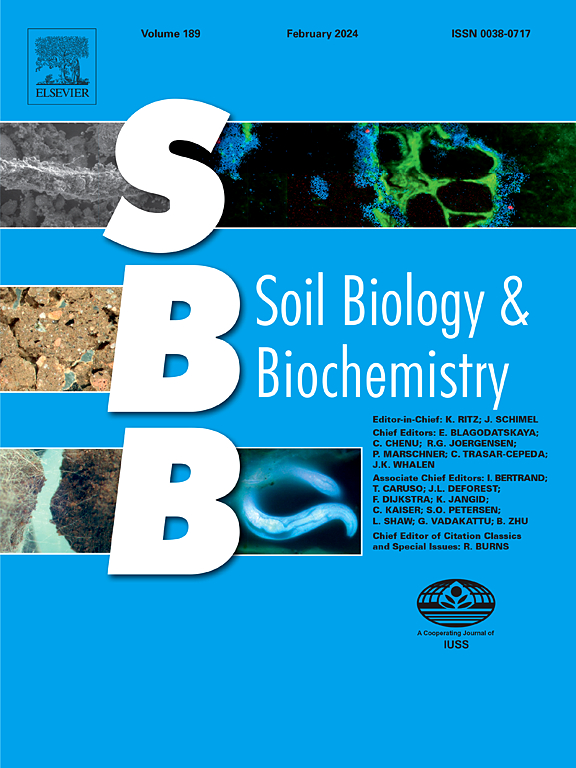Biochar-influenced solubilization and mineralization mechanisms of phosphorus in saline-sodic soils
IF 10.3
1区 农林科学
Q1 SOIL SCIENCE
引用次数: 0
Abstract
Biochar, due to its distinct physicochemical properties, holds significant potential for the remediation of saline-sodic soils and enhancing phosphorus (P) bioavailability. However, the underlying mechanisms remain incompletely understood. This study conducted a two-year field experiment applying four different rates of straw biochar (0 t/ha, 30 t/ha, 60 t/ha, and 120 t/ha) to saline-sodic soil to investigate how biochar enhances P availability. The results indicated that biochar application reduced soil pH by 6.43 %–13.17 % and electrical conductivity by 55.87 %–77.55 %. Compared to the control (no biochar), total nitrogen and soil organic carbon increased by 1.15–2.77-fold and 2.16–4.40-fold, respectively. Furthermore, biochar significantly increased microbial species abundance, particularly in bacteria (Rokubacteriales, RB41, 67_14, Vicinamibacteraceae), which changed to a more pronounced degree than fungi, indicating the possible substantial role of them over fungi for P cycling. Biochar also upregulated genes involved in phosphate uptake and P transport. Two key mechanisms were identified: (1) improvement of soil physicochemical properties and influence on metabolite abundance, which elevates CaCl2-P concentrations (on average by 97.38 %); and (2) enhancement of phosphatase content that promotes organic P mineralization by bacteria and upregulates genes (e.g., phoR and pstS) to increase available P (on average by 21.52 %). This study clarifies the mechanisms by which biochar regulates P cycling in saline-sodic ecosystems, providing a scientific basis for sustainable soil remediation and enhancing the understanding of nutrient dynamics in degraded environments.
生物炭对盐碱土中磷的增溶和矿化机制的影响
生物炭由于其独特的物理化学性质,在盐碱地的修复和提高磷的生物利用度方面具有巨大的潜力。然而,潜在的机制仍然不完全清楚。本研究通过为期两年的田间试验,在盐碱地土壤上施用4种秸秆生物炭(0 t/ hm2、30 t/ hm2、60 t/ hm2和120 t/ hm2),研究生物炭如何提高磷的有效性。结果表明,施用生物炭使土壤pH降低6.43% ~ 13.17%,电导率降低55.87% ~ 77.55%。与对照(无生物炭)相比,全氮和土壤有机碳分别增加了1.15 ~ 2.77倍和2.16 ~ 4.40倍。此外,生物炭显著增加了微生物物种丰度,特别是细菌(Rokubacteriales, RB41, 67_14, Vicinamibacteraceae),其变化程度比真菌更明显,表明它们可能比真菌在P循环中发挥重要作用。生物炭还上调了参与磷酸吸收和磷转运的基因。结果表明:(1)土壤理化性质的改善和代谢物丰度的影响,提高了cac2 - p浓度(平均提高了97.38%);(2)提高磷酸酶含量,促进细菌有机磷矿化,上调phoR和pstS等基因,提高有效磷含量(平均提高21.52%)。本研究阐明了生物炭调控盐碱生态系统磷循环的机制,为土壤可持续修复提供了科学依据,增强了对退化环境养分动态的认识。
本文章由计算机程序翻译,如有差异,请以英文原文为准。
求助全文
约1分钟内获得全文
求助全文
来源期刊

Soil Biology & Biochemistry
农林科学-土壤科学
CiteScore
16.90
自引率
9.30%
发文量
312
审稿时长
49 days
期刊介绍:
Soil Biology & Biochemistry publishes original research articles of international significance focusing on biological processes in soil and their applications to soil and environmental quality. Major topics include the ecology and biochemical processes of soil organisms, their effects on the environment, and interactions with plants. The journal also welcomes state-of-the-art reviews and discussions on contemporary research in soil biology and biochemistry.
 求助内容:
求助内容: 应助结果提醒方式:
应助结果提醒方式:


